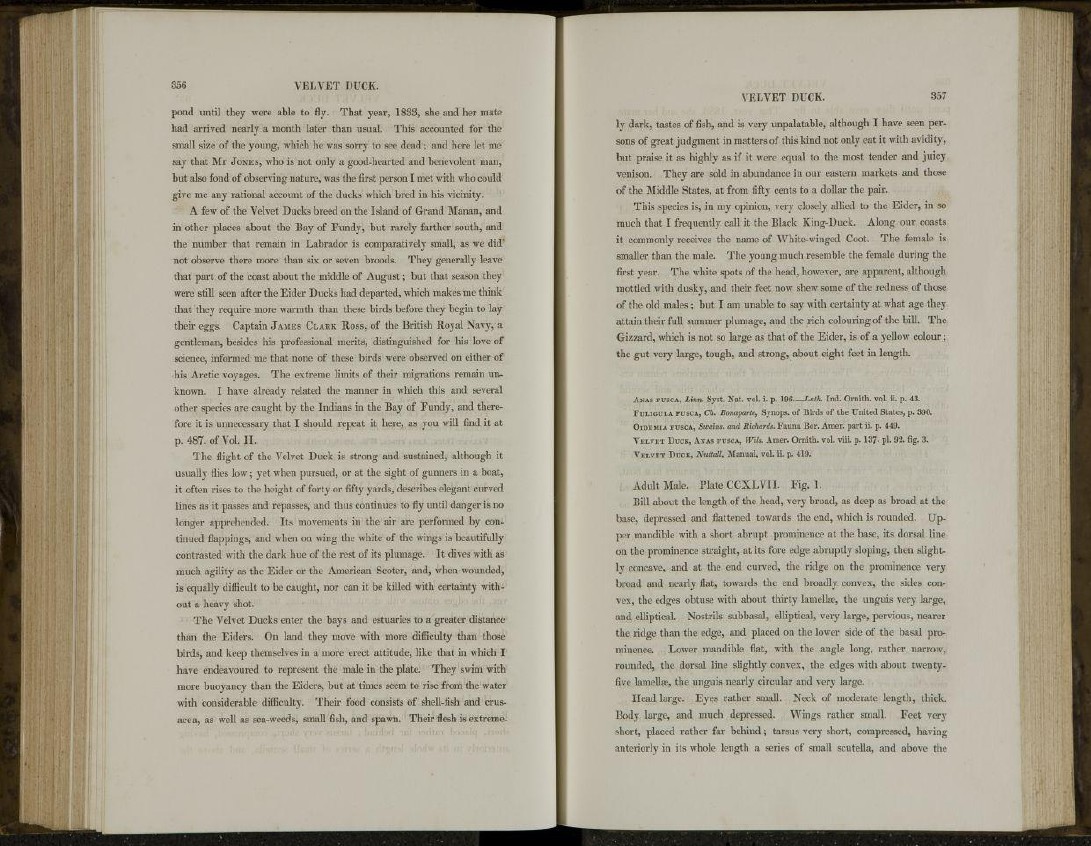
pond until they were able to fly. That year, 1833, she and her mate
had arrived nearly a month later than usual. This accounted for the
small size of the young, which he was sorry to see dead; and here let me
say that Mr JONES, who is not only a good-hearted and benevolent man,
but also fond of observing nature, was the first person I met with who could
give me any rational account of the ducks which bred in his vicinity.
A few of the Velvet Ducks breed on the Island of Grand Manan, and
in other places about the Bay of Fundy, but rarely farther south, and
the number that remain in Labrador is comparatively small, as we did'
not observe there more than six or seven broods. They generally leave
that part of the coast about the middle of August; but that season they
were still seen after the Eider Ducks had departed, which makes me think
that they require more warmth than these birds before they begin to lay
their eggs. Captain JAMES CLARK Ross, of the British Royal Navy, a
gentleman, besides his professional merits, distinguished for his love of
science, informed me that none of these birds were observed on either of
his Arctic voyages. The extreme limits of their migrations remain unknown.
I have already related the manner in which this and several
other species are caught by the Indians in the Bay of Fundy, and therefore
it is unnecessary that I should repeat it here, as you will find it at
p. 487. of Vol. II.
The flight of the Velvet Duck is strong and sustained, although it
usually flies low; yet when pursued, or at the sight of gunners in a boat,
it often rises to the height of forty or fifty yards, describes elegant curved
lines as it passes and repasses, and thus continues to fly until danger is no
longer apprehended. Its movements in the air are performed by continued
flappings, and when on wing the white of the wings is beautifully
contrasted with the dark hue of the rest of its plumage. It dives with as
much agility as the Eider or the American Scoter, and, when wounded,
is equally difficult to be caught, nor can it be killed with certainty without
a heavy shot.
The Velvet Ducks enter the bays and estuaries to a greater distance
than the Eiders. On land they move with more difficulty than those
birds, and keep themselves in a more erect attitude, like that in which I
have endeavoured to represent the male in the plate. They swim with
more buoyancy than the Eiders, but at times seem to rise from the water
with considerable difficulty. Their food consists of shell-fish and crusacea,
as well as sea-weeds, small fish, and spawn. Their flesh is extreme-
V E L V E T D U C K . 357
ly dark, tastes of fish, and is very unpalatable, although I have seen persons
of great judgment in matters of this kind not only eat it with avidity,
but praise it as highly as if it were equal to the most tender and juicy
venison. They are sold in abundance in our eastern markets and those
of the Middle States, at from fifty cents to a dollar the pair.
This species is, in my opinion, very closely allied to the Eider, in so
much that I frequently call it the Black King-Duck. Along our coasts
it commonly receives the name of White-winged Coot. The female is
smaller than the male. The young much resemble the female during the
first year. The white spots of the head, however, are apparent, although
mottled with dusky, and their feet now shew some of the redness of those
of the old males ; but I am unable to say with certainty at what age they
attain their full summer plumage, and the rich colouring of the bill. The
Gizzard, which is not so large as that of the Eider, is of a yellow colour;
the gut very large, tough, and strong, about eight feet in length.
ANAS FUSCA, Linn. Syst. Nat. vol. i. p. 196—Lath. Ind. Ornith. vol. ii. p. 43.
FULIGULA FUSCA, Ch. Bonaparte, Synops. of Birds of the United States, p. 390.
OIDEMIA FUSCA, Swains, and Bichards. Fauna Bor. Amer. part ii. p. 449.
VELVET DUCK, ANAS FUSCA, Wils. Amer. Ornith. vol. viii. p. 137- pL 92. fig. 3.
VELVET DUCK, Nuttall, Manual, vol. ii. p. 419.
Adult Male. Plate CCXLVII. Fig. 1.
Bill about the length of the head, very broad, as deep as broad at the
base, depressed and flattened towards the end, which is rounded. Upper
mandible with a short abrupt prominence at the base, its dorsal line
on the prominence straight, at its fore edge abruptly sloping, then slightly
concave, and at the end curved, the ridge on the prominence very
broad and nearly flat, towards the end broadly convex, the sides convex,
the edges obtuse with about thirty lamella?, the unguis very large,
and elliptical. Nostrils subbasal, elliptical, very large, pervious, nearer
the ridge than the edge, and placed on the lower side of the basal prominence.
Lower mandible flat, with the angle long, rather narrow,
rounded, the dorsal line slightly convex, the edges with about twentyfive
lamella?, the unguis nearly circular and very large.
Head large. Eyes rather small. Neck of moderate length, thick.
Body large, and much depressed. Wings rather small. Feet very
short, placed rather far behind; tarsus very short, compressed, having
anteriorly in its whole length a series of small scutella, and above the